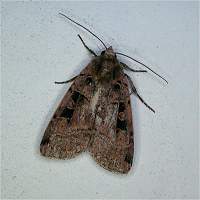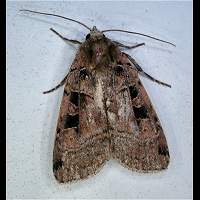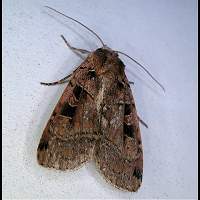Double Square Spot Xestia triangulum
The Double Square Spot is not an easy species to identify. It is similar to other Xestia species. The most striking difference compared to the Setaceous Hebrew Character is the fact that the black spot is not longer a single one (pretending to be a C), but is clearly fallen apart into two separate smaller black spots. The Triple-spotted Clay is also very similar, but it is slightly darker. Besides the white line a centimeter from the fringe of the forewing is well visible in the Double Square Spot and has an wavy indent near the tip of the wing. The Square-spotted Clay is darker and less contrastingly marked. Even though every now and then greyish animals are seen, which sometimes are rather unmarked, this species shows little variation as a rule. After some practising, this species may be identified in the field with some ease. The wingspan is 36 to 46mm.
The eggs are being laid in summer, but the first caterpillars appear in August. They overwinter when half-grown and continue their development in early spring next year. Pupation takes place underground in a light cocoon and takes some four to eight weeks. The caterpillar itself is brownish, sometimes reddish brown. It distinguishes itself of the caterpillars of other Xestia species by the bold, black lines on the segments 10 and 11. Usually they almost make up a V when put together. In autumn the larvae are usually found on lower plants, like Dock and Dandelion. After hibernation most are seen on small young Birches and Sallows and frequently on Bramble sprouts. The larvae reaches a length of some 35 to 40mm.
The Double Square Spot is on the wing mainly in June and July. It only flies by night, but is easily attracted to sugar, lights and flowering plants, including those in gardens. A common species all over Britain and Ireland, with the exception of the Shetlands and, oddly enough, Guernsey. Elsewehere in Western Europe also very common and often seen in gardens and parks, even in cities.
The Double Square Spot is not an easy species to identify. It is similar to other Xestia species. The most striking difference compared to the Setaceous Hebrew Character is the fact that the black spot is not longer a single one (pretending to be a C), but is clearly fallen apart into two separate smaller black spots. The Triple-spotted Clay is also very similar, but it is slightly darker. Besides the white line a centimeter from the fringe of the forewing is well visible in the Double Square Spot and has an wavy indent near the tip of the wing. The Square-spotted Clay is darker and less contrastingly marked. Even though every now and then greyish animals are seen, which sometimes are rather unmarked, this species shows little variation as a rule. After some practising, this species may be identified in the field with some ease. The wingspan is 36 to 46mm.
The eggs are being laid in summer, but the first caterpillars appear in August. They overwinter when half-grown and continue their development in early spring next year. Pupation takes place underground in a light cocoon and takes some four to eight weeks. The caterpillar itself is brownish, sometimes reddish brown. It distinguishes itself of the caterpillars of other Xestia species by the bold, black lines on the segments 10 and 11. Usually they almost make up a V when put together. In autumn the larvae are usually found on lower plants, like Dock and Dandelion. After hibernation most are seen on small young Birches and Sallows and frequently on Bramble sprouts. The larvae reaches a length of some 35 to 40mm.
The Double Square Spot is on the wing mainly in June and July. It only flies by night, but is easily attracted to sugar, lights and flowering plants, including those in gardens. A common species all over Britain and Ireland, with the exception of the Shetlands and, oddly enough, Guernsey. Elsewehere in Western Europe also very common and often seen in gardens and parks, even in cities.






